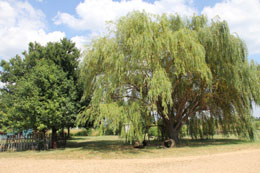The willow tree is one of the most interesting botanical specimens, which is studied by botanists and plant kingdom experts. There are three prominent types of this plant that are classified according to the color of leaves and certain physical characteristics.

The willow tree is deciduous in nature, and belongs to the botanical genus of
Salix. It is classified as an
angiosperm or
magnoliophyta, in the broader division of the plant kingdom, to accommodate its feature of bearing flowers. The tree is further classified into the sub-division of
dicotyledons, and is subsequently grouped into the order of
malpighiales, and belonging to the
Salicaceae family. The willow is principally found in the Northern hemisphere, where it thrives in the moist soil of temperate regions. It basically grows in regions, where the temperature falls below zero degree Celsius during winters. Some species that are amongst the Tundra biome organisms, share many characteristics of the arctic and alpine botanical families.
Prominent Characteristics
The willow has a strange yet wonderful physical appearance. It derives its beauty and attractiveness from its canopy, which tends to fall and sweep gracefully on a very well-balanced set of branches. The weight and balance of the canopy and branches is well sustained by a remarkably small trunk with an astoundingly small diameter. Many artists, poets, philosophers, and botanists claim that the willow tree 'thinks' and 'wonders', and provides the landscape with a calm and peaceful appearance.
The bark of this tree is soft and fibrous, with a huge content of salicylic acid, which appears on it as a abundant flowing watery sap. The leaves are elongated in an ovular fashion. Some species have smaller and shorter ovular leaves. This tree also bears flowers and fruits, which are not visible easily, as they are often camouflaged in its foliage.
Kinds of Willow Trees
Based upon their physical characteristics and the color of their leaves, these trees are often classified into different types. Described below are some of the prominent ones:
- The Weeping Willow: It is one of the most prominently found varieties, and due to its characteristic of expressing a calm sorrow, it has been given the name of willow. If we look carefully at this plant, it really does look as if it is weeping. These are fast growing trees, due to which they are often used in the landscaping designs of huge lawns or the large grassy expanses of large estate manor houses. The scientific name of this tree is Salix babylonica. It has a broad canopy of light green leaves, which turn yellow during the fall, and grow to height of 30 to 40 feet with a canopy spread of about 30 feet. It survives in different soil types, but prefers the habitat of sandy, loam, and clay. Often, it is planted on the banks of water bodies, in order to prevent excessive soil erosion.
- The Contorted Willow Tree: It is known as the Salix matsudana, and it is a close relative of the weeping willow and displays similar features. The contorted willow tree is characterized by a dark green foliage, and grows to a height of about 20 to 40 feet. The canopy size is about 15 to 30 feet, and it has a set of branches that display differing behavior in every season. The branches grow at acute angles from the main trunk, and the direction of growth slightly changes in cold and hot seasons. It has become a very popular yard tree in many cities, towns, and suburbs, due to its catchy branches.
- The Black Willow Tree: It has more of a shrub-like appearance, with a green canopy of leaves. It is botanically known as Salix nigra, and grows to a height of about 40 to 50 feet. The spread of a mature black willow tree can grow up to about 30 to 40 feet. The thick and scaly ridges that grow provide the tree with a very weather-beaten and wild appearance.
This tree does not require a lot of care if planted in a garden. Just an annual or six-monthly trim is more than sufficient for it. Some other types include the white willow, the goat willow, the Hankow willow, and the laurel willow.






 The willow tree is deciduous in nature, and belongs to the botanical genus of Salix. It is classified as an angiosperm or magnoliophyta, in the broader division of the plant kingdom, to accommodate its feature of bearing flowers. The tree is further classified into the sub-division of dicotyledons, and is subsequently grouped into the order of malpighiales, and belonging to the Salicaceae family. The willow is principally found in the Northern hemisphere, where it thrives in the moist soil of temperate regions. It basically grows in regions, where the temperature falls below zero degree Celsius during winters. Some species that are amongst the Tundra biome organisms, share many characteristics of the arctic and alpine botanical families.
The willow tree is deciduous in nature, and belongs to the botanical genus of Salix. It is classified as an angiosperm or magnoliophyta, in the broader division of the plant kingdom, to accommodate its feature of bearing flowers. The tree is further classified into the sub-division of dicotyledons, and is subsequently grouped into the order of malpighiales, and belonging to the Salicaceae family. The willow is principally found in the Northern hemisphere, where it thrives in the moist soil of temperate regions. It basically grows in regions, where the temperature falls below zero degree Celsius during winters. Some species that are amongst the Tundra biome organisms, share many characteristics of the arctic and alpine botanical families.